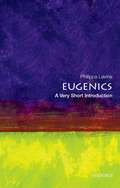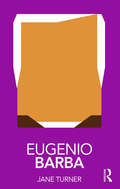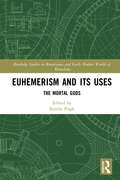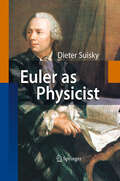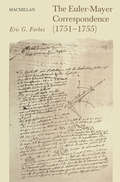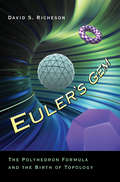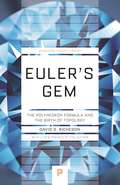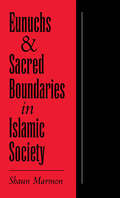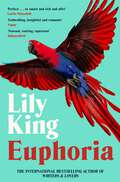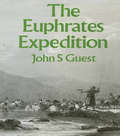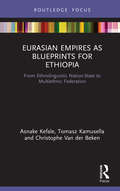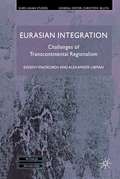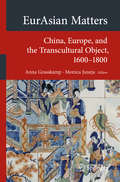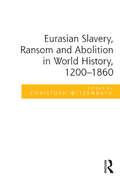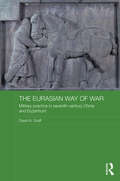- Table View
- List View
Eugenics in American Political Life: How the Politics of Superiority Still Shape Us Today
by Shannon Bow O'BrienThe book explores the development of the American eugenics movement and how it still plays a role in American life. Building on a brief overview of the concept of eugenics, Shannon Bow O’Brien charts the foundations of the ideas, significant influences, and influencers of the movement in the last 19th and early 20th centuries. She discusses how these ideals and social life shaped American culture and encouraged attitudes toward racial and ethnic biases, including immigration policies in that period. O’Brien examines how the founding of the United States of America was built on unwanted individuals from the United Kingdom; transported felons and indentured servants were many of the original colonists. As the population forged its new nation, many of these individuals were the focus of restrictive immigration policies that sought to amend the identity of the American citizen and sought to define acceptable roles for Black persons within American society. Faithful slave monuments provided physical models to help engrain these roles within American life. O’Brien traces the development of the Mammy statue movement and its intersectionality with the restrictive immigration laws. Finally, she turns to the rhetoric of Donald Trump and contextualizes his speech in the ideology of the superiority of White Nordic nativism within American life.
Eugenics: A Very Short Introduction (Very Short Introductions)
by Philippa LevineIn 1883, Francis Galton, a cousin of Charles Darwin, coined the word "eugenics" to express his dream of perfecting the human race by applying the laws of genetic heredity. Adapting Darwin's theory of evolution to human society, eugenics soon became a powerful, international movement, committed to using the principles of heredity and statistics to encourage healthy and discourage unhealthy reproduction. Early in the twentieth century and across the world, doctors, social reformers, and politicians turned to the new science of eugenics as a means to improve and strengthen their populations. Eugenics advocates claimed their methods would result in healthier, fitter babies and would dramatically limit human suffering. The reality was a different story. In the name of scientific progress and of human improvement, eugenicists targeted the weak and the sick, triggering coercive legislation on issues as disparate as race, gender, immigration, euthanasia, abortion, sterilization, intelligence, mental illness, and disease control. Nationalists eagerly embraced eugenics as a means to legitimize their countries' superiority and racialized assumptions, and the Nazis notoriously used eugenics to shape their "final solution." In this lucid volume, Philippa Levine tackles the intricate and controversial history of eugenics, masterfully synthesizing the enormous range of policies and experiments carried out in the name of eugenics around the world throughout the twentieth century. She questions the widespread belief that eugenics disappeared after World War II and evaluates the impact of eugenics on current reproductive and genetic sciences. Charting the development of such controversial practices as artificial insemination, sperm donation, and population control, this book offers a powerful, extraordinarily timely reflection on the frequent interplay between genetics and ethics. Eugenics may no longer be a household word, but we feel its effects even today.
Eugenics: A Very Short Introduction (Very Short Introductions)
by Philippa LevineIn 1883, Francis Galton, a cousin of Charles Darwin, coined the word "eugenics" to express his dream of perfecting the human race by applying the laws of genetic heredity. Adapting Darwin's theory of evolution to human society, eugenics soon became a powerful, international movement, committed to using the principles of heredity and statistics to encourage healthy and discourage unhealthy reproduction. Early in the twentieth century and across the world, doctors, social reformers, and politicians turned to the new science of eugenics as a means to improve and strengthen their populations. Eugenics advocates claimed their methods would result in healthier, fitter babies and would dramatically limit human suffering. The reality was a different story. In the name of scientific progress and of human improvement, eugenicists targeted the weak and the sick, triggering coercive legislation on issues as disparate as race, gender, immigration, euthanasia, abortion, sterilization, intelligence, mental illness, and disease control. Nationalists eagerly embraced eugenics as a means to legitimize their countries' superiority and racialized assumptions, and the Nazis notoriously used eugenics to shape their "final solution." In this lucid volume, Philippa Levine tackles the intricate and controversial history of eugenics, masterfully synthesizing the enormous range of policies and experiments carried out in the name of eugenics around the world throughout the twentieth century. She questions the widespread belief that eugenics disappeared after World War II and evaluates the impact of eugenics on current reproductive and genetic sciences. Charting the development of such controversial practices as artificial insemination, sperm donation, and population control, this book offers a powerful, extraordinarily timely reflection on the frequent interplay between genetics and ethics. Eugenics may no longer be a household word, but we feel its effects even today.
Eugenio Barba (Routledge Performance Practitioners)
by Jane TurnerEugenio Barba is recognized as one of the most important theatre practitioners working today. Along with the company he founded over fifty years ago, the world-acclaimed Odin Teatret, he continues to produce extraordinary theatre performances that tour the world, and his International School of Theatre Anthropology has greatly developed research into the craft of the actor. Now revised and updated, this volume reveals the background to and work of a major influence on twentieth- and twenty-first century performance. Eugenio Barba is the first book to combine: an overview of Barba’s work and that of his company, Odin Teatret exploration of his writings and ideas on theatre anthropology, and his unique contribution to contemporary performance research in-depth analysis of the 2000 production of Ego Faust, performed at the International School of Theatre Anthropology a practical guide to training exercises developed by Barba and the actors in the company. As a first step towards critical understanding, and as an initial exploration before going on to further, primary research, Routledge Performance Practitioners offer unbeatable value for today’s student.
Eugenio Barba (Routledge Performance Practitioners)
by Jane TurnerEugenio Barba is recognized as one of the most important theatre practitioners working today. Along with the company he founded over fifty years ago, the world-acclaimed Odin Teatret, he continues to produce extraordinary theatre performances that tour the world, and his International School of Theatre Anthropology has greatly developed research into the craft of the actor. Now revised and updated, this volume reveals the background to and work of a major influence on twentieth- and twenty-first century performance. Eugenio Barba is the first book to combine: an overview of Barba’s work and that of his company, Odin Teatret exploration of his writings and ideas on theatre anthropology, and his unique contribution to contemporary performance research in-depth analysis of the 2000 production of Ego Faust, performed at the International School of Theatre Anthropology a practical guide to training exercises developed by Barba and the actors in the company. As a first step towards critical understanding, and as an initial exploration before going on to further, primary research, Routledge Performance Practitioners offer unbeatable value for today’s student.
Euhemerism and Its Uses: The Mortal Gods (Routledge Studies in Renaissance and Early Modern Worlds of Knowledge)
by Syrithe PughEuhemerism and Its Uses offers the first interdisciplinary, focussed, and all-round view of the long history of an important but understudied phenomenon in European intellectual and cultural history. Euhemerism – the claim that the Greek gods were historically mortal men and women – originated in the early third century BCE, in an enigmatic and now fragmentary text by the otherwise unknown author Euhemeros. This work, the Sacred Inscription, has been read variously as a theory of religion, an atheist’s manifesto, as justifying or satirizing ruler-worship, as a fantasy travel-narrative, and as an early ‘utopia’. Influencing Hellenistic and Roman literature and religious and political thought, and appropriated by early Christians to debunk polytheism while simultaneously justifying the continued study of classical literature, euhemerism was widespread in the middle ages and Renaissance, and its reverberations continue to be felt in modern myth-theory. Yet, though frequently invoked as a powerful and pervasive tradition across several disciplines, it is still under-examined and poorly understood. Filling an important gap in the history of ideas, this volume will appeal to scholars and students of classical reception, mediaeval and Renaissance literature, historiography, and theories of myth and religion.
Euhemerism and Its Uses: The Mortal Gods (Routledge Studies in Renaissance and Early Modern Worlds of Knowledge)
by Syrithe PughEuhemerism and Its Uses offers the first interdisciplinary, focussed, and all-round view of the long history of an important but understudied phenomenon in European intellectual and cultural history. Euhemerism – the claim that the Greek gods were historically mortal men and women – originated in the early third century BCE, in an enigmatic and now fragmentary text by the otherwise unknown author Euhemeros. This work, the Sacred Inscription, has been read variously as a theory of religion, an atheist’s manifesto, as justifying or satirizing ruler-worship, as a fantasy travel-narrative, and as an early ‘utopia’. Influencing Hellenistic and Roman literature and religious and political thought, and appropriated by early Christians to debunk polytheism while simultaneously justifying the continued study of classical literature, euhemerism was widespread in the middle ages and Renaissance, and its reverberations continue to be felt in modern myth-theory. Yet, though frequently invoked as a powerful and pervasive tradition across several disciplines, it is still under-examined and poorly understood. Filling an important gap in the history of ideas, this volume will appeal to scholars and students of classical reception, mediaeval and Renaissance literature, historiography, and theories of myth and religion.
Euler as Physicist
by Dieter SuiskyThe subject of the book is the development of physics in the 18th century centered upon the fundamental contributions of Leonhard Euler to physics and mathematics. This is the first book devoted to Euler as a physicist. Classical mechanics are reconstructed in terms of the program initiated by Euler in 1736 and its completion over the following decades until 1760. The book examines how Euler coordinated his progress in mathematics with his progress in physics.
The Euler-Mayer Correspondence (1751–1755): A New Perspective on Eighteenth-Century Advances in the Lunar Theory (pdf)
by Leonhard Euler Tobias MayerEuler's Gem: The Polyhedron Formula and the Birth of Topology
by David S. RichesonLeonhard Euler's polyhedron formula describes the structure of many objects--from soccer balls and gemstones to Buckminster Fuller's buildings and giant all-carbon molecules. Yet Euler's formula is so simple it can be explained to a child. Euler's Gem tells the illuminating story of this indispensable mathematical idea. From ancient Greek geometry to today's cutting-edge research, Euler's Gem celebrates the discovery of Euler's beloved polyhedron formula and its far-reaching impact on topology, the study of shapes. In 1750, Euler observed that any polyhedron composed of V vertices, E edges, and F faces satisfies the equation V-E+F=2. David Richeson tells how the Greeks missed the formula entirely; how Descartes almost discovered it but fell short; how nineteenth-century mathematicians widened the formula's scope in ways that Euler never envisioned by adapting it for use with doughnut shapes, smooth surfaces, and higher dimensional shapes; and how twentieth-century mathematicians discovered that every shape has its own Euler's formula. Using wonderful examples and numerous illustrations, Richeson presents the formula's many elegant and unexpected applications, such as showing why there is always some windless spot on earth, how to measure the acreage of a tree farm by counting trees, and how many crayons are needed to color any map. Filled with a who's who of brilliant mathematicians who questioned, refined, and contributed to a remarkable theorem's development, Euler's Gem will fascinate every mathematics enthusiast.
Euler's Gem: The Polyhedron Formula and the Birth of Topology
by David S. RichesonLeonhard Euler's polyhedron formula describes the structure of many objects--from soccer balls and gemstones to Buckminster Fuller's buildings and giant all-carbon molecules. Yet Euler's formula is so simple it can be explained to a child. Euler's Gem tells the illuminating story of this indispensable mathematical idea. From ancient Greek geometry to today's cutting-edge research, Euler's Gem celebrates the discovery of Euler's beloved polyhedron formula and its far-reaching impact on topology, the study of shapes. In 1750, Euler observed that any polyhedron composed of V vertices, E edges, and F faces satisfies the equation V-E+F=2. David Richeson tells how the Greeks missed the formula entirely; how Descartes almost discovered it but fell short; how nineteenth-century mathematicians widened the formula's scope in ways that Euler never envisioned by adapting it for use with doughnut shapes, smooth surfaces, and higher dimensional shapes; and how twentieth-century mathematicians discovered that every shape has its own Euler's formula. Using wonderful examples and numerous illustrations, Richeson presents the formula's many elegant and unexpected applications, such as showing why there is always some windless spot on earth, how to measure the acreage of a tree farm by counting trees, and how many crayons are needed to color any map. Filled with a who's who of brilliant mathematicians who questioned, refined, and contributed to a remarkable theorem's development, Euler's Gem will fascinate every mathematics enthusiast.
Euler's Gem: The Polyhedron Formula and the Birth of Topology
by David S. RichesonHow a simple equation reshaped mathematicsLeonhard Euler’s polyhedron formula describes the structure of many objects—from soccer balls and gemstones to Buckminster Fuller’s buildings and giant all-carbon molecules. Yet Euler’s theorem is so simple it can be explained to a child. From ancient Greek geometry to today’s cutting-edge research, Euler’s Gem celebrates the discovery of Euler’s beloved polyhedron formula and its far-reaching impact on topology, the study of shapes. Using wonderful examples and numerous illustrations, David Richeson presents this mathematical idea’s many elegant and unexpected applications, such as showing why there is always some windless spot on earth, how to measure the acreage of a tree farm by counting trees, and how many crayons are needed to color any map. Filled with a who’s who of brilliant mathematicians who questioned, refined, and contributed to a remarkable theorem’s development, Euler’s Gem will fascinate every mathematics enthusiast. This paperback edition contains a new preface by the author.
Euler's Gem: The Polyhedron Formula and the Birth of Topology
by David S. RichesonHow a simple equation reshaped mathematicsLeonhard Euler’s polyhedron formula describes the structure of many objects—from soccer balls and gemstones to Buckminster Fuller’s buildings and giant all-carbon molecules. Yet Euler’s theorem is so simple it can be explained to a child. From ancient Greek geometry to today’s cutting-edge research, Euler’s Gem celebrates the discovery of Euler’s beloved polyhedron formula and its far-reaching impact on topology, the study of shapes. Using wonderful examples and numerous illustrations, David Richeson presents this mathematical idea’s many elegant and unexpected applications, such as showing why there is always some windless spot on earth, how to measure the acreage of a tree farm by counting trees, and how many crayons are needed to color any map. Filled with a who’s who of brilliant mathematicians who questioned, refined, and contributed to a remarkable theorem’s development, Euler’s Gem will fascinate every mathematics enthusiast. This paperback edition contains a new preface by the author.
Eunuchs and Sacred Boundaries in Islamic Society (Studies in Middle Eastern History)
by Shaun MarmonIn this thought-provoking interdisciplinary work, Shaun Marmon describes how eunuchs, as a category of people who embodied ambiguity, both defined and mediated critical thresholds of moral and physical space in the household, in the palace and in the tomb of pre-modern Islamic society. The author's central focus is on the sacred society of eunuchs who guarded the tomb of the Prophet Muhammad in Medina for over six centuries and whose last representatives still perform many of their time honored rituals to this day. Through Marmon's account, the "sacred" eunuchs of Medina become historical guides into uncharted dimensions of Islamic ritual, political symbolism, social order, gender and time.
Euphoria
by Lily KingTHE NEW YORK TIMES TOP TEN BESTSELLERWINNER OF THE 2014 KIRKUS PRIZE FOR FICTIONInspired by the true story of a woman who changed the way we understand our world.In 1933 three young, gifted anthropologists are thrown together in the jungle of New Guinea. They are Nell Stone, fascinating, magnetic and famous for her controversial work studying South Pacific tribes, her intelligent and aggressive husband Fen, and Andrew Bankson, who stumbles into the lives of this strange couple and becomes totally enthralled. Within months the trio are producing their best ever work, but soon a firestorm of fierce love and jealousy begins to burn out of control, threatening their bonds, their careers, and, ultimately, their lives . . .'Dazzling' Emma Donoghue, author of Room
Euphrates Expedition
by John. S. GuestFirst published in 1992. This book invites the reader to cast the mind a hundred and fifty years back to a short span of time between 1829 and 1842. This was an exciting period when Britain’s might, demonstrated to the world at Trafalgar and Waterloo, was fortified by leadership in steam technology and was given a new direction by the liberal philosophy that British statesmen, thinkers and poets proclaimed at home and abroad. The Euphrates expedition was an attempt by well-intentioned British governments to achieve a geopolitical end by a technological means. The objective was to halt Russian expansion in the Near East, where some observers saw a threat to Britain’s control of India.
Euphrates Expedition
by John. S. GuestFirst published in 1992. This book invites the reader to cast the mind a hundred and fifty years back to a short span of time between 1829 and 1842. This was an exciting period when Britain’s might, demonstrated to the world at Trafalgar and Waterloo, was fortified by leadership in steam technology and was given a new direction by the liberal philosophy that British statesmen, thinkers and poets proclaimed at home and abroad. The Euphrates expedition was an attempt by well-intentioned British governments to achieve a geopolitical end by a technological means. The objective was to halt Russian expansion in the Near East, where some observers saw a threat to Britain’s control of India.
Eurasia
by Christopher EvansIn "Eurasia" the author describes an ideal republic where many of the problems that confront us are worked out. The book describes in an interesting and readable way how government is administered in this ideal republic. The government is one in which women take their full share of responsibility, the school children are trained in the problems they will meet in life, and more emphasis is laid on character building than on the dead languages. The children of both sexes are taught useful trades. All school children are taught to swim. The idle are employed in the construction of roads, canals and irrigation works. The problems of distribution are so arranged that the worker receives a more equitable reward for his labor.
Eurasian Empires as Blueprints for Ethiopia: From Ethnolinguistic Nation-State to Multiethnic Federation (Routledge Studies in Modern History)
by Asnake Kefale Tomasz Kamusella Christophe Van der BekenThis book is a contribution to the global history of the transfer of political ideas, as exemplified by the case of modern Ethiopia. Like many non-European nation-states, Ethiopia adopted a western model of statehood, that is, the nation-state. Unlike the postcolonial polities that have retained the mode of statehood imposed on them by their colonial powers, Ethiopia was never successfully colonized leaving its ruling elite free to select a model of ‘modern’ (western) statehood. In 1931, via Japan, they adopted the model of unitary, ethnolinguistically homogenous nation-state, in turn copied by Tokyo in 1889 from the German Empire (founded in 1871). Following the Ethiopian Revolution (1974) that overthrew the imperial system, the new revolutionary elite promised to address the ‘nationality question’ through the marxist-leninist model. The Soviet model of ethnolinguistic federalism (originally derived from Austria-Hungary) was introduced in Ethiopia, first in 1992 and officially with the 1995 Constitution. To this day the politics of modern Ethiopia is marked by the tension between these two opposed models of the essentially central European type of statehood. The late 19th-century ‘German-German’ quarrel on the ‘proper’ model of national statehood for Germany – or more broadly, modern central Europe – remains the quarrel of Ethiopian politics nowadays. The book will be useful for scholars of Ethiopian and African history and politics, and also offers a case in comparative studies on the subject of different models of national statehood elsewhere.
Eurasian Empires as Blueprints for Ethiopia: From Ethnolinguistic Nation-State to Multiethnic Federation (Routledge Studies in Modern History)
by Asnake Kefale Tomasz Kamusella Christophe Van der BekenThis book is a contribution to the global history of the transfer of political ideas, as exemplified by the case of modern Ethiopia. Like many non-European nation-states, Ethiopia adopted a western model of statehood, that is, the nation-state. Unlike the postcolonial polities that have retained the mode of statehood imposed on them by their colonial powers, Ethiopia was never successfully colonized leaving its ruling elite free to select a model of ‘modern’ (western) statehood. In 1931, via Japan, they adopted the model of unitary, ethnolinguistically homogenous nation-state, in turn copied by Tokyo in 1889 from the German Empire (founded in 1871). Following the Ethiopian Revolution (1974) that overthrew the imperial system, the new revolutionary elite promised to address the ‘nationality question’ through the marxist-leninist model. The Soviet model of ethnolinguistic federalism (originally derived from Austria-Hungary) was introduced in Ethiopia, first in 1992 and officially with the 1995 Constitution. To this day the politics of modern Ethiopia is marked by the tension between these two opposed models of the essentially central European type of statehood. The late 19th-century ‘German-German’ quarrel on the ‘proper’ model of national statehood for Germany – or more broadly, modern central Europe – remains the quarrel of Ethiopian politics nowadays. The book will be useful for scholars of Ethiopian and African history and politics, and also offers a case in comparative studies on the subject of different models of national statehood elsewhere.
Eurasian Integration: Challenges of Transcontinental Regionalism (Euro-Asian Studies)
by E. Vinokurov A. LibmanThe Eurasian continent, which has for over a century lagged behind in global markets, is currently gaining economic and political momentum. This book investigates emerging economic linkages in the area, examining the factors shaping this integration, the benefits and risks involved, and the future of these states on the global stage.
EurAsian Matters: China, Europe, and the Transcultural Object, 1600-1800 (Transcultural Research – Heidelberg Studies on Asia and Europe in a Global Context)
by Anna Grasskamp Monica JunejaThe volume examines the mutually constitutive relationship between the materiality of objects and their aesthetic meanings. Its approach connects material culture with art history, curation, technologies and practices of making. A central dimension of the case studies collected here is the mobility of objects between Europe and China and the transformations that unfold as a result of their transcultural lives. Many of the objects studied here are relatively unknown or understudied. The stories they recount suggest new ways of thinking about space, cultural geographies and the complex and often contradictory association of power and culture. These studies of transcultural objects can suggest pathways for museum experts by uncovering the multi-layered identities and temporalities of objects that can no longer be labelled as located in single regions. It is also addressed to students of art history, of European and Chinese studies and scholars of consumer culture.« This eagerly awaited volume offers deep and extensive insights into the fast-growing field of material culture studies. Its fresh approach to Eurasian objects and materialities will serve as useful reading for all scholars interested in transcultural and global studies. A very helpful introductory essay. » Sabine du Crest, University of Bordeaux Montaigne, Former Fellow, The Harvard University Center for Italian Renaissance Studies.
Eurasian Slavery, Ransom and Abolition in World History, 1200-1860
by Christoph WitzenrathRecent research has demonstrated that early modern slavery was much more widespread than the traditional concentration on plantation slavery in the context of European colonial expansion would suggest. Slavery and slave trading, though little researched, were common across wide stretches of Eurasia, and a slave economy played a vital part in the political and cultural contacts between Russia and its Eurasian neighbours. This volume concentrates on captivity, slavery, ransom and abolition in the vicinity of the Eurasian steppe from the early modern period to recent developments and explores their legacy and relevance down to the modern times. The contributions centre on the Russian Empire, while bringing together scholars from various historical traditions of the leading states in this region, including Poland-Lithuania and the Ottoman Empire, and their various successor states. At the centre of attention are transfers, transnational fertilizations and the institutions, rituals and representations facilitating enslavement, exchanges and ransoming. The essays in this collection define and quantify slavery, covering various regions in the steppe and its vicinity and looking at trans-cultural issues and the implications of slavery and ransom for social, economic and political connections across the steppe. In so doing the volume provides both a broad overview of the subject, and a snapshot of the latest research from leading scholars working in this area.
Eurasian Slavery, Ransom and Abolition in World History, 1200-1860
by Christoph WitzenrathRecent research has demonstrated that early modern slavery was much more widespread than the traditional concentration on plantation slavery in the context of European colonial expansion would suggest. Slavery and slave trading, though little researched, were common across wide stretches of Eurasia, and a slave economy played a vital part in the political and cultural contacts between Russia and its Eurasian neighbours. This volume concentrates on captivity, slavery, ransom and abolition in the vicinity of the Eurasian steppe from the early modern period to recent developments and explores their legacy and relevance down to the modern times. The contributions centre on the Russian Empire, while bringing together scholars from various historical traditions of the leading states in this region, including Poland-Lithuania and the Ottoman Empire, and their various successor states. At the centre of attention are transfers, transnational fertilizations and the institutions, rituals and representations facilitating enslavement, exchanges and ransoming. The essays in this collection define and quantify slavery, covering various regions in the steppe and its vicinity and looking at trans-cultural issues and the implications of slavery and ransom for social, economic and political connections across the steppe. In so doing the volume provides both a broad overview of the subject, and a snapshot of the latest research from leading scholars working in this area.
The Eurasian Way of War: Military Practice in Seventh-Century China and Byzantium (Asian States and Empires)
by David A. GraffThis book is a comparative study of military practice in Sui-Tang China and the Byzantine Empire between approximately 600 and 700 CE. It covers all aspects of the military art from weapons and battlefield tactics to logistics, campaign organization, military institutions, and the grand strategy of empire. Whilst not neglecting the many differences between the Chinese and Byzantines, this book highlights the striking similarities in their organizational structures, tactical deployments and above all their extremely cautious approach to warfare. It shows that, contrary to the conventional wisdom positing a straightforward Western way of war and an "Oriental" approach characterized by evasion and trickery, the specifics of Byzantine military practice in the seventh century differed very little from what was known in Tang China. It argues that these similarities cannot be explained by diffusion or shared cultural influences, which were limited, but instead by the need to deal with common problems and confront common enemies, in particular the nomadic peoples of the Eurasian steppes. Overall, this book provides compelling evidence that pragmatic needs may have more influence than deep cultural imperatives in determining a society’s "way of war."

